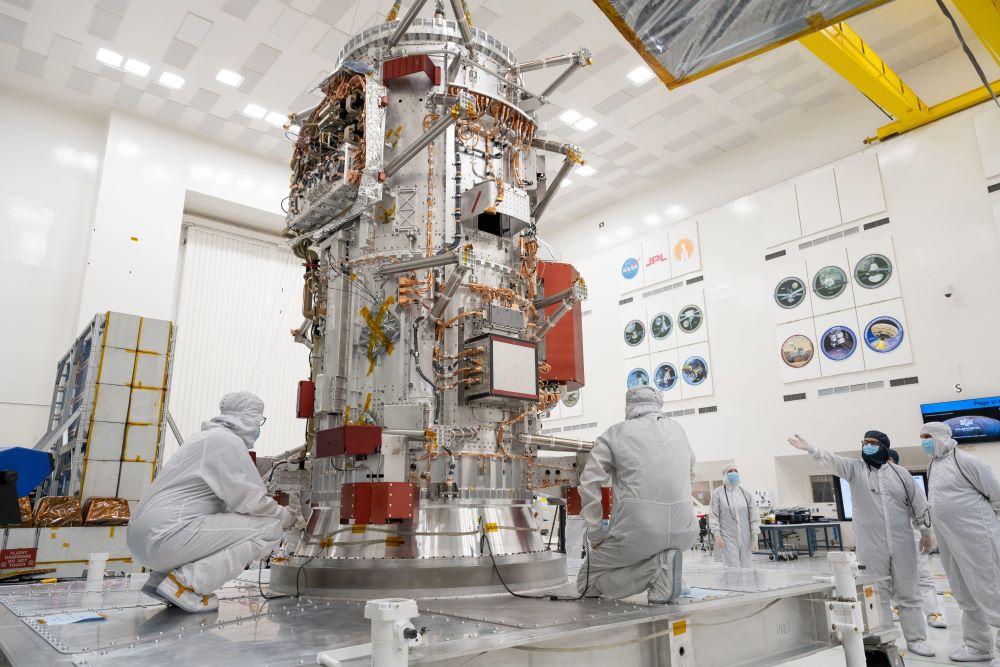
Europa Clipper module.
Launch activity on Florida’s Space Coast is on hold due to Hurricane Milton.
Both Cape Canaveral SFS and NASA’s Kennedy Space Center (KSC) have activated storm preparation, monitoring and assessment protocols to ensure employee safety and protect mission-critical infrastructure and property.
NASA’s Europa Clipper spacecraft is riding out the storm inside SpaceX’s hangar at KSC’s Launch Complex 39A. The planned Oct. 10 launch aboard a Falcon Heavy is postponed until after any storm damage assessments. The launch window to send the spacecraft on its six-year journey toward Jupiter closes Nov. 6.
Florida weather is also delaying the return of the SpaceX Crew-8 mission from the International Space Station (ISS). The agency is now targeting undocking for no earlier than 3:05 a.m. EDT Oct. 13.
The Florida-bound Hurricane Milton, as well as Hurricane Helene’s recent rampage through North Carolina, prompted the FCC to issue a temporary authorization for SpaceX to operate its Starlink-T-Mobile direct-to-cell texting service to provide emergency alerts for all phones and carriers of the affected areas.
Meanwhile in Boca Chica Beach, Texas, SpaceX is preparing for its fifth integrated flight test (IFT-5) of the Starship-Super Heavy vehicle. The company is hoping to launch as early as Oct. 13. The FAA last week said it does not expect to be finished reviewing SpaceX’s revised flight plan for IFT-5—which includes an attempt to land the Super Heavy at the launchpad instead of a splashdown in the Gulf of Mexico—until late November.
On Oct. 9, the FAA said SpaceX submitted new information for IFT-5 in mid-August and that the proposal was under review. “The FAA will make a licensing determination once SpaceX has met all licensing requirements,” the agency said.
The FAA did clear SpaceX for launch of a Falcon 9 rocket with the European Space Agency’s (ESA) Hera asteroid probe despite an unrelated ongoing investigation into an upper-stage anomaly that occurred as part of the successful SpaceX Crew-9 launch on Sept. 28.
The Hera mission, which launched on Oct. 7 from Cape Canaveral SFS, did not require an upper-stage reentry burn, so the problem that occurred following deployment of the Crew-9 Dragon spacecraft was moot.
Due to a suspected fuel leak, the Crew-9 upper stage had an off-nominal deorbit burn, a maneuver designed to mitigate debris in low Earth orbit (LEO) and ensure stage reentry over an unpopulated area for public safety.
The stage landed safely in the ocean, but outside of the targeted area, SpaceX said. The company suspended Falcon 9 flights and launched an investigation, as per FAA regulations.
For launching Hera, the FAA determined that “the absence of a second stage reentry for this mission adequately mitigates the primary risk to the public in the event of a reoccurrence of the mishap experienced with the Crew-9 mission.
“Safety will drive the timeline for the FAA to complete its review of SpaceX’s Crew-9 mishap investigation report and when the agency will authorize Falcon 9 to return to regular operations,” the FAA said.
Among the missions on hold are a Falcon 9 launch from Vandenberg SFB, California, with the final members of OneWeb’s first-generation LEO broadband network.





